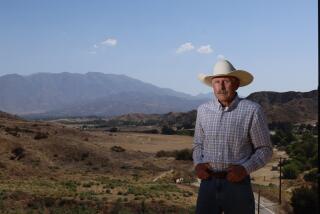History digs in against retailer
- Share via
Like Civil War generals, the generals of modern commercial development are attracted to large open spaces along well-traveled roads, typically on the outskirts of a town or major population center. The former picked those sites for battlefields a century and a half ago; the latter like them today for big-box stores.
And once again, great armies are mustering on the Virginia Piedmont -- historians and preservationists on one side, big retail and developers on the other -- this time in cash-strapped Orange County, 60 miles south of Washington, where Wal-Mart wants to build a supercenter opposite the Wilderness Battlefield.
There, in May 1864, 24,000 soldiers were killed or wounded in the first clash between Gen. Robert E. Lee and Gen. Ulysses S. Grant -- famously hellish combat in a burning thicket of scrub oak and spindly pine trees. The National Park Service owns 2,800 acres of the core battlefield, whose larger area extends across nearly 7,000 acres.
That land is mostly undeveloped, and to Wal-Mart, it looks like a prime retail location. The parcel where the company plans to build its 138,000-square-foot store and parking lot has long been zoned for commercial development but has little more than a small shopping plaza opposite a gas station. There are also preliminary plans for a larger retail, office and residential complex, Wilderness Crossing, that would be built adjacent to the Wal-Mart, but no formal proposals have been submitted.
Neither the supercenter nor the larger complex would be on the core battlefield area.
A study commissioned by the company found that the parcel is not historically or archaeologically significant.
But opponents contend that the supercenter would unleash a wave of sprawling development through the area, marring the mostly rural landscape and the memory of the dead. The Battle of the Wilderness was the first clash in the long Overland Campaign that would end the war 11 months later at Appomattox Courthouse, according to Pulitzer Prize-winning historian James McPherson.
“The Wilderness is an indelible part of our history, its very ground hallowed by the American blood spilled there, and it cannot be moved,” read a letter signed by McPherson and 252 other historians and preservationists that was sent recently to Wal-Mart’s president and chief executive, Lee Scott. “Surely Wal-Mart can identify a site that would meet its needs without changing the very character of the battlefield.”
The letter’s signatories include a who’s who of Civil War heavyweights: filmmaker Ken Burns, Pulitzer winner David McCullough, University of Virginia professor Garry Gallagher, Virginia Tech Center for Civil War Studies Executive Director James Robertson and other scholars.
“Every one of these modern intrusions on the historic landscape degrades the value and experience of that landscape,” said McPherson, who said that he has been to the proposed site and that a Wal-Mart would take development in the area “a quantum leap higher.”
Keith Morris, a spokesman for Wal-Mart, said that the company has looked at other locations in the area but that none was as attractive.
Preservation groups in Virginia have generally been successful in recent years in steering development projects away from battlefields or reaching compromises with builders that result in partial protection for historic sites. But that was before the economic slump.
“I think economic downturns clarify some things,” said R. Mark Johnson, chairman of the Orange County Board of Supervisors, which will ultimately decide on the proposal. “In this environment, to have a major retailer like Wal-Mart still want to come in is fairly significant and not something we can be casual about.”
More to Read
Inside the business of entertainment
The Wide Shot brings you news, analysis and insights on everything from streaming wars to production — and what it all means for the future.
You may occasionally receive promotional content from the Los Angeles Times.










